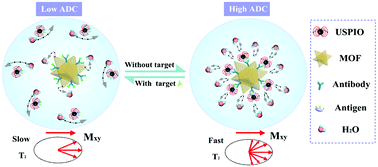Assembly of USPIO/MOF nanoparticles with high proton relaxation rates for ultrasensitive magnetic resonance sensing†
Abstract
Transverse proton relaxation time (T2)-mediated magnetic resonance sensing (MRS) with simple pretreatment has drawn increasing attention for the development of biosensors whereas conventional MRS is not competent for detecting trace targets due to its relatively low sensitivity. We herein develop ultrasensitive T2-MRS that enables the detection of trace bisphenol A (BPA) based on the assembly of ultra-small superparamagnetic iron oxide (USPIO) nanoparticles and metal organic framework (MOF) materials. The assembly has a higher T2 proton relaxation rate than that of the dispersed USPIO nanoparticles, which is due to the higher apparent diffusion coefficient of the assembly. This enhancement is attributed to the porous structure of the MOF, which reduces the amount of water molecules entering the magnetic cores of the USPIO nanoparticles. The strategy is capable of sensing BPA in a linear range of 5 to 1000 pg mL−1 with a limit of detection (LOD) of 1.3 pg mL−1, which is higher than that of conventional MRS (detection limit of 0.14 ng mL−1). Moreover, the practicability of the strategy was verified by detecting BPA in samples of canned oranges and Ipoh water. This method does not need complicated pretreatment steps and is easy to operate.

- This article is part of the themed collection: Journal of Materials Chemistry C Emerging Investigators


 Please wait while we load your content...
Please wait while we load your content...